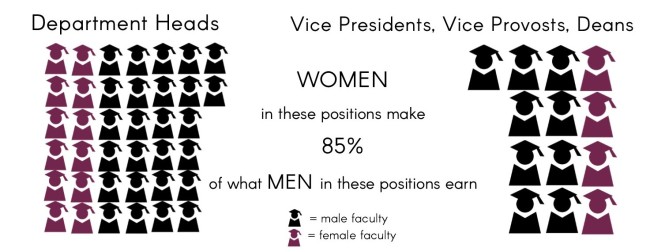Data collected from the 2014 census and salary information indicate the presence of a gender pay gap at the College of William and Mary. The gap is slightly less significant than the one in Virginia, where, controlling for hours worked, occupation, college major, employment sector and other factors conditional to pay, median full-time earnings for women were 79 percent of the median full-time earnings for men.
Out of vice provosts, vice presidents, deans and department heads, women at the College are paid 85 percent of what men in these positions earn.
Out of 38 department heads, only 12 are female. Out of 13 vice provosts, vice presidents and deans, only four are female. The College has only had one female provost, and has never had a female president. Out of the 10 highest earners at the College, only one is a woman.
Assistant Director of Institutional Research at the College Sophy Feng, said that gender could affect salary at the College.
“A lot of factors affect one’s salary — gender may or may not be one of them,” Feng said.
A lot of factors affect one’s salary — gender may or may not be one of them,” Feng said.
Feng explained that, particularly at institutions of higher education, it is difficult to isolate gender as a variable. The salary of a professor, department head and even dean depends significantly on the discipline. Salaries for medical sciences such as biology and chemistry, law, engineering and computer science tend to be significantly higher than humanities and arts salaries.
At the College, this is often the case, with the highest department-head salaries in physics, biology and chemistry, in addition to disciplines such as government and international relations. Gendered trends in both students and faculty in the various academic disciplines exist. Although there are more female science majors than male, the chemistry, biology and physics department heads are all men. Mathematics and computer science have a majority male faculty and both have male department heads.
The Global Studies department, which consists of four area studies departments, should theoretically have similarly-paid department heads for each area study as all fall under the same department. In reality, European Studies, Asian and Middle Eastern Studies, and Russian and Post-Soviet Studies each have male heads of department who are all paid approximately $80,000. However, the head of the Latin American Studies department, who is female, is paid around $8,000 less, at $72,000.
In the employee climate survey conducted in 2015, male and female employees responded unfavorably at equal rates when asked about their pay, with the rate at approximately 33 percent. Responses regarding merit-based advancement and fair compensation were more gendered, with female employees rating the College about 10 percent less favorably in both areas. 41 percent of women said they believe they are not fairly compensated for their work, as opposed to 33 percent of men. Likewise, 34 percent of women believe advancement at the College is not based on merit, as opposed to 23 percent of men.
In professional roles, such as senior administrative positions, fair compensation questions elicited less of a gendered gap, but responses from women in professional roles regarding advancement based on merit showed a 20 percent more unfavorable answer rate when compared their male counterparts’ answers.
Chief Human Resources Officer John Poma ’86 discussed these disparities. The College has a lot of tenured professors, making hiring new and more diverse faculty, especially for higher-paying and more prestigious jobs, difficult.
“It limits the ability of individuals to move into those positions,” Poma said.
Although recent female hires in the highly-paid senior administrative positions make a difference in closing the gap between male and female salaries there are still things to be done, according to Poma.
“Just like society, there are areas that we need to improve upon,” Poma said.
Just like society, there are areas that we need to improve upon,” Poma said.
Economics professor Peter McHenry specialises in United States labour economics.
“There is discrimination in the U.S. labour market,” McHenry said, “But I’m not happy saying [there is discrimination] at William and Mary.”
In his research on faculty pay at the College McHenry found that, controlling for department and rank, salary disparity between genders does not exist. He did find, however, that there was a negative correlation between the number of women in a department and the average salary level of the department as a whole. He said the problem could be that women are either hired more often or choose to pursue lower-paying disciplines more frequently.
Looking at female-to-male ratios in each rank of a department, the tenured professors in higher ranks tend to be older males. However, when you follow the ranks down to the graduate level, regardless of discipline, the ratios become much more even.
Poma said both the Human Resources Department and the Provost’s Office are working toward a more equitable system, with the goal of a more diverse and content workforce at the College.

